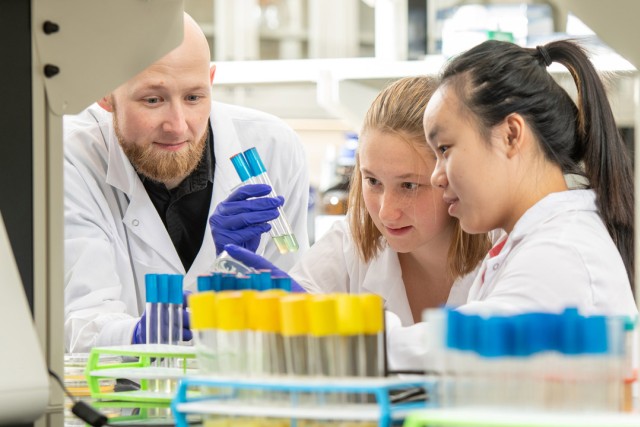Biomedical engineering researcher awarded grant to study chronic skin fibrosis
Karin Wuertz-Kozak becomes first RIT researcher to receive Congressional special-interest medical research funding
Elizabeth Lamark
Karin Wuertz-Kozak, RIT’s Kate Gleason Endowed Professor, is researching skin fibrosis through a prestigious grant from the Congressional Directed Medical Research Program.
More collagen in the human body is not always good, and Karin Wuertz-Kozak is investigating how disease progresses because of the increase in this important protein.
Wuertz-Kozak recently received more than $400,000 from the Congressional Directed Medical Research Program (CDMRP) to investigate new therapeutic approaches for scleroderma, a chronic autoimmune disease that involves overproduction of collagen, also referred to as fibrosis.
“Collagen is one of the most important matrix proteins in your body. And although a loss of collagen is associated with numerous diseases, overproduction of collagen also has detrimental effects, as seen during scleroderma,” said Wuertz-Kozak, the Kate Gleason Endowed Professor in the biomedical engineering department at Rochester Institute of Technology.
The CDMRP is a Department of Defense funding initiative to transform healthcare and encourage new treatment alternatives. Wuertz-Kozak is the first faculty member at RIT to be funded through this initiative, and she will partner with Benjamin Korman, physician and assistant professor of allergy/immunology and rheumatology at the University of Rochester Medical Center, to develop new testing models and treatment options.
Scleroderma is not easily diagnosed and, to date, there are limited treatments for this progressive disease that leads to hardening and tightening of the skin and impaired movement. It can also affect other organs, such as the lungs, where fibrosis and scarring inhibits breathing.
Wuertz-Kozak and her team will develop 3D skin models that can be used to simulate and assess fibrotic disease onset, progression, and treatment using a cutting-edge technology called electrospinning. The process entails a high voltage applied to a polymer solution creating minute, nanoscale fibers. The accumulated material on a grounded collector plate resemble natural collagen fibers.
“Using variations in this process and the selected polymers, you can create nanofibrous constructs simulating different types of tissues,” she said. “We started doing this as a way to have a more cost effective and controllable, high-throughput system for skin testing that can be used as an alternative to animal testing. For our skin model, we combine classical electrospinning with cryogenic electrospinning to create bi-layered tissue constructs that simulate the dense structure of the epidermis and the more fluffy structure of the dermis.”
There are several aspects to the overall project. The first involves developing a model of fibrotic skin using this double-layered technique. To induce overproduction of collagen, dermal cells seeded in these carriers require additional stimuli, such as treatment with the growth factor TGF-beta and exposure to serum from scleroderma patients, she explained.
In the second project part, Wuertz-Kozak’s training as a pharmacist becomes evident. Prior to coming to RIT, she was trained in pharmacology and has extensive experience in orthopedic research and biomechanics. This experience is essential as she investigates whether overproduction of collagen in this model—and ultimately in patients—can be reversed, or paused, through pharmacological approaches.
“First results look really promising,” said Wuertz-Kozak, who has been working on ion channels in health and disease for more than five years.
The interdisciplinary project extends for three years. Early work had been conducted by Andrea De Pieri, who joined Wuertz-Kozak’s Tissue Regeneration and Mechanobiology lab in 2020 as a post-doctoral researcher. He is originally from Italy and obtained his Ph.D. in Ireland. More recently, Patricia Alvaro Llopis from Spain joined the team.
Wuertz-Kozak is an international scholar herself. Originally from Germany, she worked in Vermont and Switzerland before joining RIT’s Kate Gleason College of Engineering in 2019. Her expertise is in understanding cellular mechanisms and underlying pathologies of inflammation toward new treatment options and of tissue regeneration and pain reduction. She has acquired nearly $2 million in organizational funding since joining RIT and is involved in many national and international research collaborations.
“Our research will lay the groundwork to better understand the molecular mechanisms underlying the development and progression of scleroderma,” said Wuertz-Kozak. “This could be a way to realize improvements in the care and quality of life of those affected by scleroderma-induced skin alterations.”



